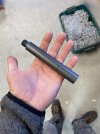I know it will reduce velocity, but I was wondering about the other points in my post.
"I know chopping the barrel will reduce muzzle velocity, but does that shift the nodes, require you to find completely new nodes, or does the same grains of powder yield another node, but just at that lower velocity?
My guess is that you need to re-establish a new node because of barrel harmonics changing.
One other question, lets say my 24" bbl 7mm rem mag shoots this 168gr ABLR really well with 62gr of 4000-MR. If i chop 6" off the barrel, the velocity will lower, but will the chamber pressure also decrease?"

